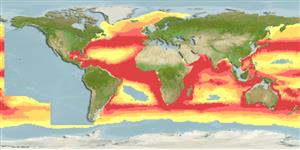Actinopterygii (ray-finned fishes) >
Zeiformes (Dories) >
Parazenidae (Parazen) > Cyttopsinae
Etymology: Cyttopsis: Greek, kyttaros, kytos = a convex cavity + Greek, opsis = appearance.
Environment / Climate / Range
Ecology
Marine; bathypelagic; depth range 150 - 730 m (Ref. 9563), usually 330 - 690 m (Ref. 7251). Deep-water, preferred ?
Western Atlantic: Canada (Ref. 5951) to southeastern USA and northern Gulf of Mexico to western Caribbean (Ref. 7251); northern coast of South America (Ref. 5217). Eastern Atlantic: Bay of Biscay round the South African coast to Natal. Indian Ocean: Somalia (Ref. 30573) and off the south-west coast of India. Western Pacific: off Japan, eastern Australia (Ref. 7300) and New Zealand (Ref. 5755).
Size / Weight / Age
Maturity: Lm ? range ? - ? cm
Max length : 31.0 cm TL male/unsexed; (Ref. 6953); common length : 25.0 cm TL male/unsexed; (Ref. 2683)
Dorsal
spines
(total): 7 - 8;
Dorsal
soft rays
(total): 28-30;
Anal
spines: 1-2;
Anal
soft rays: 29 - 30. Rosy pink and silvery in color; pelvic fins reddish with black membranes (Ref. 4253). Mouth large, oblique, highly protrusible; anteriorly directing spine in a series on supraorbital; pelvic fin spine soft, flexible; pelvic fin soft rays long, the longest reaching 5th anal ray when depressed; 1st anal spine large and immovable, 2nd one small and moveable (Ref. 13608).
Occurs on the continental slope (Ref. 75154). Bathypelagic (Ref. 5951). Forms schools. Feeds on other fishes and swimming decapod crustaceans (Ref. 4968).
Life cycle and mating behavior
Maturity | Reproduction | Spawning | Eggs | Fecundity | Larvae
Heemstra, P.C., 1995. Additions and corrections for the 1995 impression. p. v-xv. In M.M. Smith and P.C. Heemstra (eds.) Revised Edition of Smiths' Sea Fishes. Springer-Verlag, Berlin. (Ref. 11228)
IUCN Red List Status (Ref. 115185)
CITES (Ref. 94142)
Not Evaluated
Threat to humans
Harmless
Human uses
Fisheries: commercial
More information
ReferencesAquacultureAquaculture profileStrainsGeneticsAllele frequenciesHeritabilityDiseasesProcessingMass conversion
Tools
Special reports
Download XML
Internet sources
